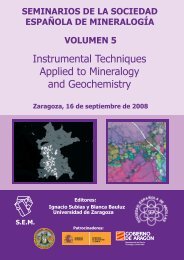2011 Jornada CientÃfica de la Sociedad Española de Arcillas 14 de ...
2011 Jornada CientÃfica de la Sociedad Española de Arcillas 14 de ...
2011 Jornada CientÃfica de la Sociedad Española de Arcillas 14 de ...
Create successful ePaper yourself
Turn your PDF publications into a flip-book with our unique Google optimized e-Paper software.
<strong>Jornada</strong> Científica <strong>de</strong> <strong>la</strong> <strong>Sociedad</strong> Españo<strong>la</strong> <strong>de</strong> Arcil<strong>la</strong>s. <strong>14</strong> <strong>de</strong> Noviembre <strong>de</strong> <strong>2011</strong><br />
LIPID-BASED BIO-NANOHYBRIDS FOR THERMAL STABILIZATION OF<br />
VIRAL SPECIES AND APPLICATION AS INFLUENZA VACCINES<br />
B. Wicklein*, M.A. Martin <strong>de</strong>l Burgo**, M. Yuste**, M. Dar<strong>de</strong>r*, P. Aranda*, J.<br />
Ortin***, G. <strong>de</strong>l Real**, E. Ruiz-Hitzky*<br />
*Instituto <strong>de</strong> Ciencia <strong>de</strong> Materiales <strong>de</strong> Madrid, CSIC. Cantob<strong>la</strong>nco, 28049<br />
Madrid<br />
**Instituto Nacional <strong>de</strong> Investigación y Tecnología Agraria y Alimentaria, Ctra.<br />
<strong>de</strong> <strong>la</strong> Coruña Km 7,5, 28040 Madrid<br />
***Centro Nacional <strong>de</strong> Biotecnología, CSIC, Cantob<strong>la</strong>nco, 28049 Madrid<br />
We report the preparation and efficacy testing of influenza A vaccines<br />
composed of bio-nanohybrids based on phospholipid modified c<strong>la</strong>ys [1] as<br />
carrier for either inactivated influenza A virus particles (PR8/H1N1) or the main<br />
surface influenza antigen hemagglutinin (HA) (Fig. 1A and B) [2]. Thermal<br />
stabilization of vaccines during shipment and distribution is a challenging task,<br />
especially in <strong>de</strong>veloping countries. To address this question, we have <strong>de</strong>signed<br />
a novel carrier p<strong>la</strong>tform based on two types of c<strong>la</strong>ys, sepiolite and Mg/Al type<br />
<strong>la</strong>yered double hydroxi<strong>de</strong>, disp<strong>la</strong>ying biomimetic lipid interfaces to ensure native<br />
and maximum stability of immobilized antigens. It is well known that solid<br />
adjuvants as vaccine carriers may inflict conformational alterations on the<br />
antigen by strong interactions and thus, diminish its immunogenic potential [3].<br />
Therefore, lipid bi<strong>la</strong>yer membranes are incorporated to modu<strong>la</strong>te these<br />
interactions. In addition to the use of the whole viral particle, the surface antigen<br />
HA was also immobilized on the lipid interface mimicking its localization on the<br />
viral membrane. As a result, these vaccine modifications preserved the<br />
biological nature of the antigens (Fig. 1C), elicited virus-specific antibodies in<br />
mice and showed higher thermal stability as compared to aluminum salts, the<br />
currently most wi<strong>de</strong>ly used antigenic adjuvant [4].<br />
87













